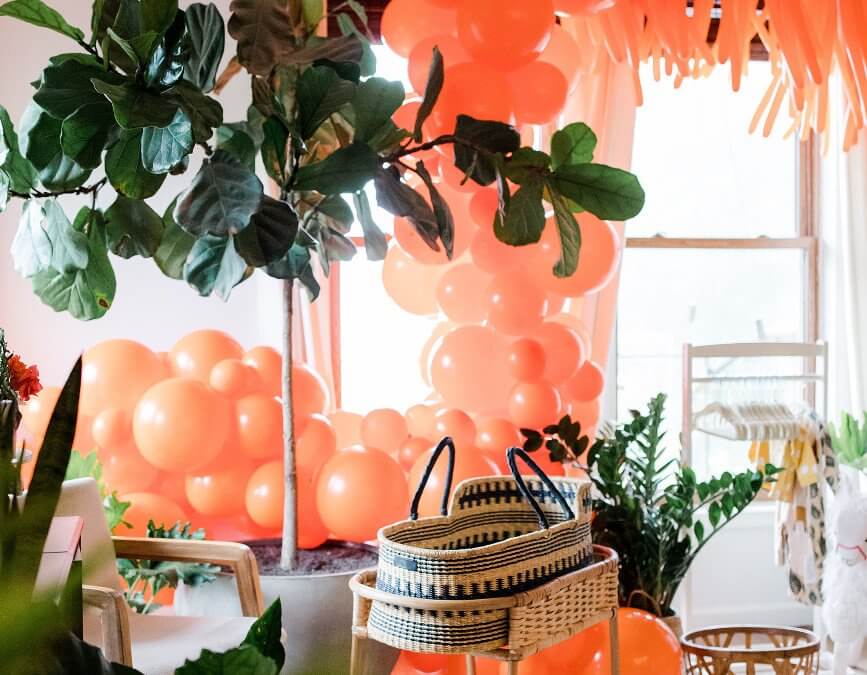The Fiddle-Leaf Fig
Part 2 in our Houseplant Mini-series
Part two of our new mini-series highlighting individual house plants features Ficus lyrata commonly known as the Fiddle-Leaf Fig. You’ve probably seen them used in home decor magazines and highlighted in the stylized photos on Instagram for the last number of years. With the right light and care, they can be an incredible addition to your home.
Ficus lyrata need a lot of bright light to full sun. A room filled with windows or right up at a Southeast window would be perfect. You may have seen photographs with these trees placed in lower light scenarios. Remember, it’s just for the designer’s photo, it’s not an example of where to place these live trees. They need at least 6 hours of bright sunlight every day.
Watering these trees correctly is the next best way to keep them their healthiest. They like to go about ¾ of the way dry in their pots before you water them again. You can check that with your finger, a wooden dowel, long wooden chopstick or kabob skewer or even a moisture meter to see how low the soil’s moisture is. When it’s dry enough, fill a large watering can with lukewarm water and water the soil thoroughly until it just begins to trickle out of the bottom of the pot. Placing the pot in a large plastic tub placed right next to where you keep the plant makes watering large indoor trees a breeze as you only need to move and lift it a few inches to take it in and out. Never let it sit in leftover water.
Potting a Fiddle-leaf fig: As with all plants, the best time to repot is in the Spring and Summer when the plant is actively growing. Depending on how rootbound it currently is, it’s best to always repot plants into a container no wider than 2” of its current diameter. Plant the tree no deeper than it is potted in its current state. The soil you should use should be well draining. It should be made for houseplants and it should not be labeled “Moisture Control”. Those soils are made for plants that like to stay moist or that use up the moisture in the soil rapidly, such as outdoor potted annuals.
Because of their size, keeping the trees in plastic “grower’s pots” can make repotting and even watering easier. The trees can grow very large and be quite heavy. Lifting a tree that’s living inside a plastic grower’s pot is much easier than one that is planted directly inside of a glazed ceramic pot. Then it can easily be hidden down inside a decorative pot or basket.
Pruning: Because these plants can easily outgrow most homes, it’s good to get comfortable with pruning. Pruning also helps maintain the tree’s shape and height. It’s best to do any pruning when the tree is actively growing. Prune right above a leaf joint.
Summering Outdoors: Lots of houseplants enjoy spending their summers outdoors where the temperatures are warm and the air is humid. Air conditioning tends to dry out the air and many of us keep it cooler than tropical houseplants like. When nights average 60 degrees, it’s safe to place your houseplants outdoors. Making sure to do this gradually is essential. When first taking them outdoors, put them in a shady or protective area so the sun’s UV light does not burn the leaves as they haven’t been exposed to them indoors.. Then gradually place them in filtered light until you eventually move them to their permanent summer position. Being outdoors and being exposed to the elements, you can get away with lower light than you do outdoors.
Preventing problems and Dusting: A good rule of thumb is to keep houseplants free of dust and debris. A habit to adopt should be to keep a wet washcloth with you on the day that you water your Ficus lyrata. While the plant is absorbing the water, you can gently wipe the dust off of each leaf. If you’d like to use a product like LeafShine, do so only when the plant is kept indoors as an outdoor plant will be very prone to sunburn with the product on its leaves. To clean the leaves, place a hand under the bottom of the leaf and use your other hand to wipe the leaf. If you are just using a clean wet washcloth, you can wipe the undersides of the leaves if they need it. Do not use LeafShine products on the underside of leaves as it will clog their pores. If the pores are clogged the plant cannot take in Carbon Dioxide and release oxygen. Keeping the top of the soil free of debris is also important. Houseplants do not have the elements to help breakdown things that fall onto the soil and leaving them there attracts pests. Keeping the trees properly watered, dusted and free of debris can help prevent an infestation from occurring.
Check back with Modern Foliage next time when we will discover why succulents may be the most misunderstood houseplants.
Missi Lackas, blog writer for Modern Foliage Designs.
missi@modernfoliage.com



